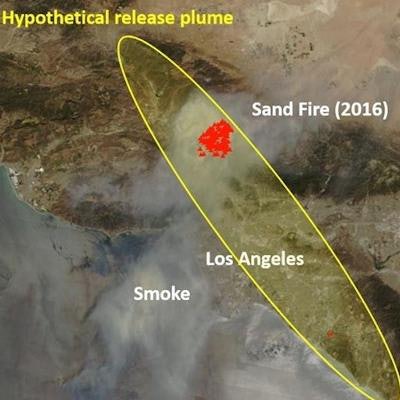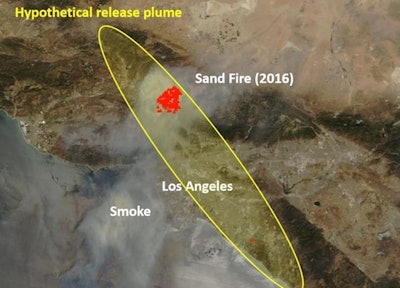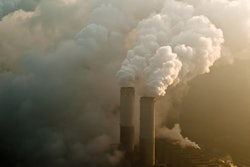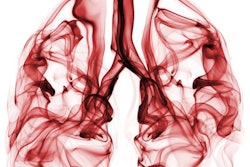
With the 2021 wildfire season set to burn millions of acres on the U.S. West Coast, federal scientists recently considered an alarming hypothetical: What if a raging fire engulfed an area contaminated by radiation on the outskirts of Los Angeles?
"Large wildfires in areas contaminated due to a radiological incident could result in significant exposure to first responders and downwind population areas," wrote a group of U.S. Environmental Protection Agency and U.S. Forestry Service scientists.
In a study published July 5 in Science of the Total Environment, the group developed a prediction model based on weather patterns and data from carbon emissions from the 2016 Sand Fire in Los Angeles County's Santa Clarita Valley. They added radiation emissions to the model based on what has been observed in fires in areas contaminated with cesium (Cs-137) from the Chernobyl power plant accident in 1986.
 Graphic abstract. Image courtesy of Science of the Total Environment.
Graphic abstract. Image courtesy of Science of the Total Environment.Predicted exposures from radiation emitted by the fire would be below levels requiring evacuation or sheltering in place, the authors found. Moreover, first responders would be more likely to have negative health impacts from other pollutants than from so-called legacy radioactive Cs-137.
External exposure to large amounts of Cs-137 can cause burns, acute radiation sickness, and death. Nuclear power plant accidents, improvised nuclear device detonations, and radiological dispersal devices ("dirty bombs") can introduce radionuclides into the environment, potentially contaminating large areas, the authors wrote. Large wildfires in contaminated forested areas have the potential to reintroduce these radionuclides into the atmosphere and cause exposure to first responders and downwind communities, they stated.
In this study, the researchers developed a photochemical grid model to estimate radiation levels in downwind particulate matter. The highest emissions estimates per fuel consumed in lab tests for fine (0.006 g/kg) and coarse (0.008 g/kg) particulate matter were selected for the wildfire to provide a conservative estimate of Cs-137's impact.
The model predicted that ambient levels both near the wildfire and further downwind in nearby urban areas would be below levels requiring population evacuation or other protective actions, such as shelter-in-place, according to the scientists. The maximum predicted coarse particulate matter deposition was 1,118 Bq/m2, while fine fraction deposition totals were much lower at 82 Bq/m2.
Moreover, laboratory testing of wildfire combustion suggests the fate of Cs-137 is largely associated with ash rather than air emissions, the scientists wrote.
Ultimately, however, exposure would depend on the levels of radionuclide in the fire's fuel, while downwind impacts follow the region's wind patterns, which are hard to predict, the authors noted.
"Other similar assessments suggest it is possible that external irradiation from deposited Cs-137 could result in a larger exposure than the inhalation pathway assessed here," they wrote.
Cs-137 is water-soluble, has a long half-life (30.17 years), and can easily be taken up by plants. These properties mean a long residence time in soil and biomass contaminated by radiological incidents and thus may increase reemission potential during wildland fire activity, the authors wrote.
"It is important to understand the potential post-incident impacts of Cs-137 from a typical wildfire to characterize exposure to support prioritization of post-incident remediation efforts," the scientists concluded.




















